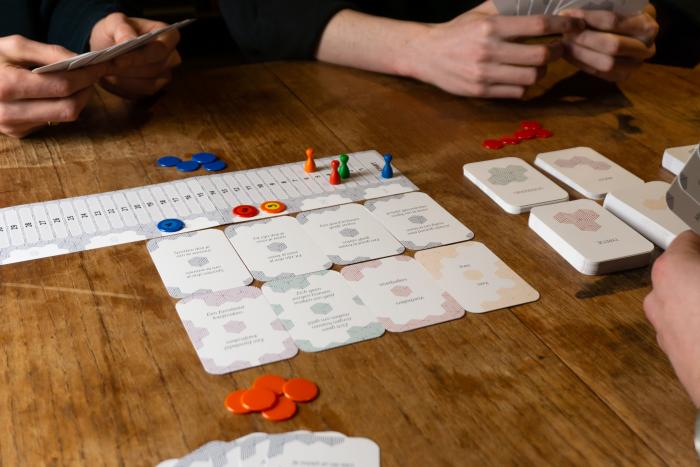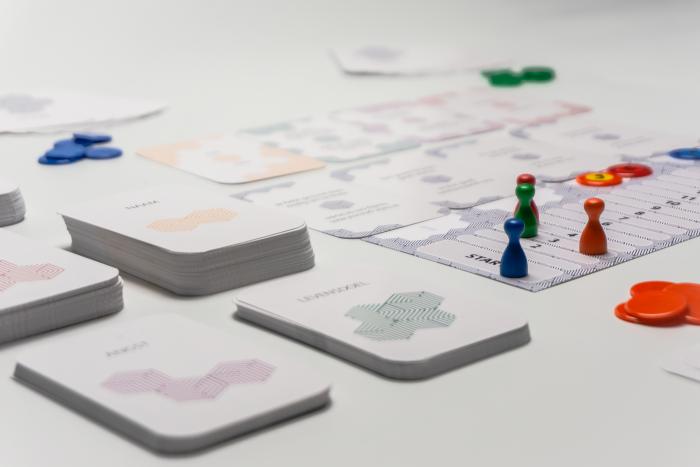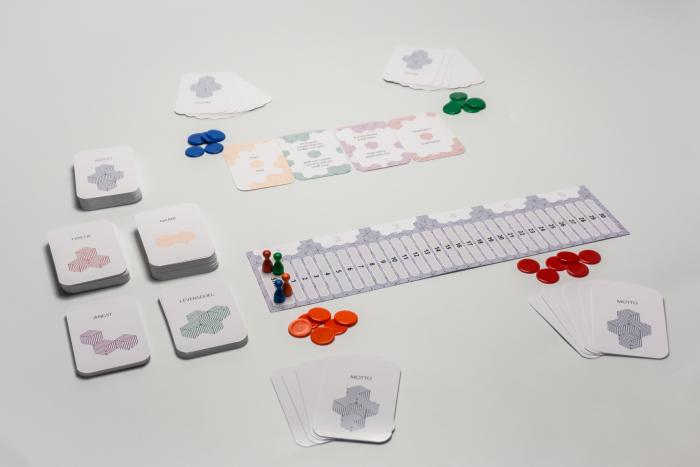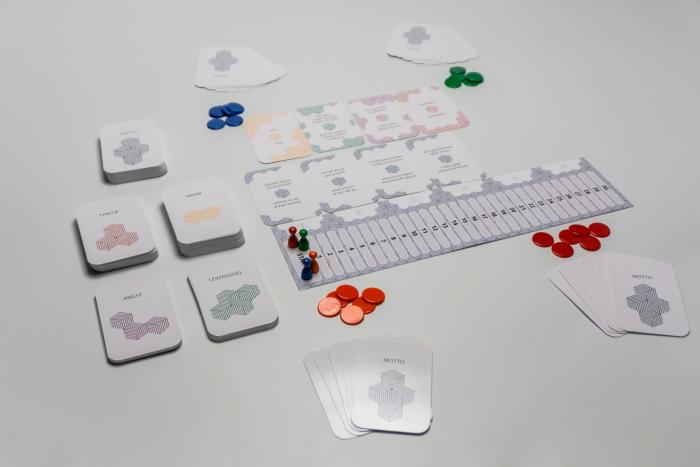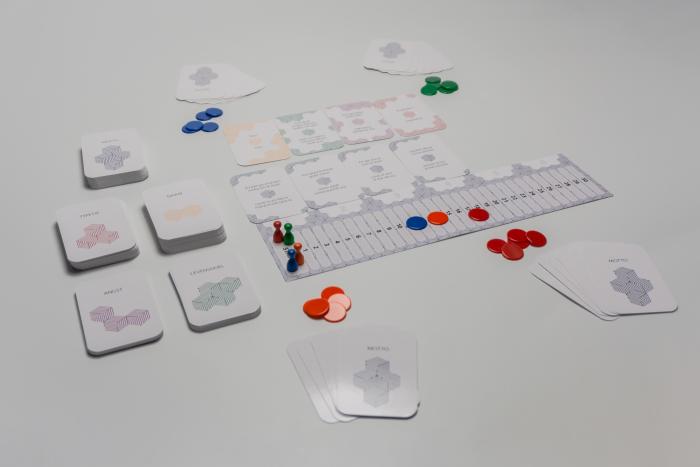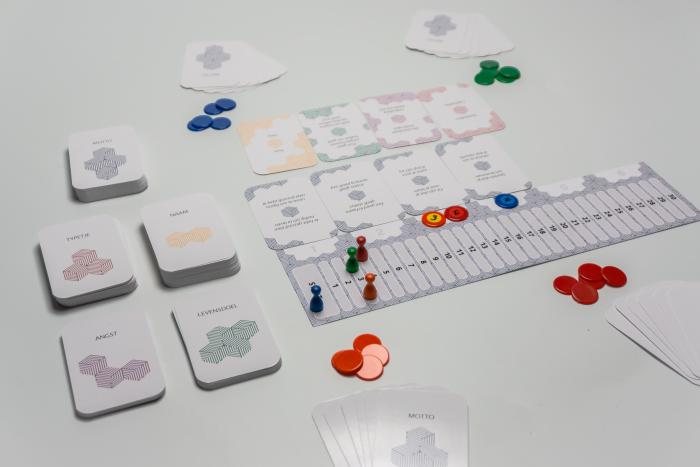IMAGO is a fun and light-hearted game that invites adolescents to discuss dominant cultural beliefs about appearance and discover that there are more differences between people’s personal motivations and aspirations than they may know.
Loneliness is a large and growing problem among adolescents. Body image has a strong relationship with loneliness, especially among young people. Therefore, a promising way to increase social wellbeing among this group is by increasing body satisfaction. This concept consists of a serious game that can tackle this subject within and outside of the classroom.
Cognitive models theorise loneliness as a consequence of bad coping behaviours for body dissatisfaction, among other things. Body dissatisfaction often results from internalising dominant cultural beliefs about appearance. Changing these beliefs is difficult and slow, but a good place to start is by realising there is often more nuance and variety in beliefs (about being healthy and fit) than we assume. While one person values a low-fat sixpack for the hard work that goes into it, another values the freedom a healthy and able body provides. It seems these behaviours and beliefs are closely related to expressing identity and feeling connected with others. This leads us to the question: Are there no other, more socially healthy ways to create this connection?
IMAGO offers a fun and light-hearted reason for adolescents to discuss their aspirations and the influence of dominant cultural beliefs, and discover that there are more differences between people’s personal motivations and aspirations than they may realise. The game achieves this by using several innovative game mechanics both to create a safe social environment for discussion, encourage players to empathise with different perspectives and trigger conversation about difficult topics in a casual manner.
Prototypes of the game have been tested with the user group and experts in the field and have been found promising. The Rising Star prize would enable further development, testing, redesign and promotion of the game for use in schools and households throughout the Dutch language area and translation of the game into other languages.
Please highlight how the concept/idea can be exemplary in this context
Based on user testing, it was found that the most effective environment for adolescents to exchange meaningful viewpoints on body image and cultural beliefs is a safe and accessible physical environment. Based on this insight, the project developed into a physical serious game for tabletop use. The game is made up of several sets of playing cards: ‘character creation cards’, and ‘motto cards’. These playing cards can be manufactured from sustainably sourced materials and made to fit within existing fully recyclable waste streams. In line with objectives, this ensures the full material circularity of the design.
The character creation cards use four attributes to build a character of stereotypes: the player randomly draws a name, a (high-school) stereotype, a life goal and a greatest fear. Some of these attributes may at first seem contradictory, but with closer inspection, they often combine into an interesting persona. Players may recognise names, cliques from school and their own goals and fears. The characters serve as a way to move the game to a mental ‘safe space’, where players can distantiate from their personal experience through these proxy personas.
The motto cards consist of cultural beliefs associated with the topic of body image. Many of the mottos are (in)direct quotes concerning topics related to body image from participants of the co-creation workshops held during the development of the concept.
The remaining playing materials such as voting chips, points counters, instruction booklets, playing board and storage box can also be manufactured from sustainable sources of paper, carton and wood in line with the objective of full circularity. To reach a broader audience and reduce the impact of manufacturing and transport, it is also possible to supply online instructions for creating DIY playing materials.
Please highlight how the concept/idea can be exemplary in this context
The project defined several objectives for the concept for it to fullfill the design goal: “Invite youth to find a healthy balance in their physical and social wellbing by providing a light-hearted reason and opportunity to discuss their beliefs about appearance with their peers.” Firstly, it should convey a message: “People are diverse and not everyone has the same beliefs, motivations and goals (relating to body image). You can decide for yourself.” Players realise this while playing the game as it rewards taking a different perspective and challenging stereotypes. Secondly, the game has to take place in a socially and physically safe environment, and be engaging. There should also be an opportunity for players to listen to each other and find room for reflection during or after the game.
The game achieves this through its game mechanics. Each round, one player is the storyteller, who draws one of every character attribute and lays them on the table. They choose one of several motto cards in their hand to play. Based on the character and their motto, they tell a short (fictional) story. Other players choose one of their own mottos that they find fitting with this character and the story. The chosen mottos are shuffled and placed on the table. All the players now (simultaneously) vote for the motto they think the storyteller originally played. They earn points if they are correct, and extra points if other players think the motto they played was the storyteller’s. The storyteller earns points for every player that guessed the right motto. However, there is one caveat: if all players guess the storyteller’s motto correctly, the storyteller loses points! This probably means their story was too stereotypical!
After every round, players can discuss why they associated a certain motto (or belief) with the character on the table or why they voted differently from each other. When played in the classroom, a teacher could use this to open up a further discussion.
Please highlight how the concept/idea can be exemplary in this context
Co-creation was a core theme during the development of the concept. Research preceding concept development focused on the existing experiences of adolescents and how they view issues around body image. Insights from workshops were used as input for the design process, for example in the creation of ‘character creation cards’ and ‘motto cards’.
The concept as a whole has the objective to: “Invite youth to find a healthy balance in their physical and social wellbeing by providing a light-hearted reason and opportunity to discuss their beliefs about appearance with their peers.” The message conveyed during the serious game, however, is: “People are diverse and not everyone has the same beliefs, motivations and goals (relating to body image). You can decide for yourself.” In this sense, the core purpose of the serious game is to invite adolescents to reflect on the (cultural) origins of their beliefs and empathise with various different (cultural) perspectives. These can be both the perspectives of actual players within their group, but also the perspectives of the characters ‘generated’ during the game and the beliefs they are associated with.
The tabletop form of the game is preferred for effectiveness and can be used within all types of schools, after school clubs and educational programmes. The materials can also be combined in unlimited new ways, based on the creativity of players and teachers. As discussed above, the playing set could be made DIY with online instructions or expanded with included blank cards on which players can write their own stereotypes and mottos.
Finally, the game concept and information can be shared digitally at a low cost and if the opportunity allows, players can share their own variants on the game rules or playing cards with each other.
Please highlight how this approach can be exemplary
Summarising, the serious game concept combines a low environmental cost with a high quality of experience for adolescents playing the game and discussing beliefs during and after play. The message conveyed through the game mechanics encourages adolescents to empathise with others’ perspectives and reflect on the origin of their own beliefs and/or prejudices. This encourages players to discuss inclusion and empathise with perspectives that may be different to theirs. At the same time, the game facilitates an environment in which this can be discussed in a safe social environment, through the use of fictional proxy characters and their beliefs.
The game design and prototypes were evaluated by experts and users. Although the tests did not yet provide conclusive results about its performance in achieving the primary goal of the design and further validation is still necessary, the game was generally received well and judged to be fun and have potential. Additional improvements for immersion and educational value were suggested. Though not yet fully ready for wide-scale use, the game is a promising concept. With several tweaks and a more elaborate game narrative and visual style, the game could become an effective intervention encouraging adolescents to discuss cultural beliefs about appearance and through this improve their social wellbeing and sense of belonging among their peers.
This game concept is the product of my master thesis for Strategic Product Design at the TU Delft. For more information, visit: http://resolver.tudelft.nl/uuid:b5d7a2ea-6374-4b70-b456-637537807457
Today, and especially during the COVID lockdowns throughout the world, many adolescents are used to communicating online, in short bursts of information. However, online and at school, they have little opportunity to casually discuss deeper beliefs and personal issues, such as those around body image. During the research for this project, the same adolescents indicated a lack of opportunity in their regular lives to reflect and discuss these kinds of topics with peers, but interestingly also the wish to do so. The workshops with adolescents during the development of this concept were well received and even experienced as ‘eye-openers’ for several participants. This concept is ambitious in that it aims to enable others to make it easier to replicate this experience. It it meant for playing in school, but also within families and hopefully even in groups of friends. The concept aims to lower the threshold and provide a casual opportunity to discuss deeper beliefs and aspirations with peers, as many adolescents participating in the workshops indicated a need for this in their lives.
Serious games are an up-and-coming innovative vehicle for education and communication. This concept aims to further blur the lines between serious games and actual games, by creating a fun game which broaches certain sensitive topics around the dinner table or in the classroom, while also providing a safe social environment through its mechanics.
As described earlier, based on the first user tests, there are certain areas of the concept still to improve. The concept should be tested more thoroughly and be redesigned to include a more meaningful in-game narrative, add several more explicit triggers for conversation or discussion and exaggerate the visual style of beliefs and stereotypes in the game. Mottos can be added or rephrased to better fit the target group and additional materials should be included with the game for use within the classroom.
Once the first version of the game is ready for release, a promotional strategy needs to be created together with our partners in the fields of education and young-adult health. This strategy should place importance on the agency of the target group themselves to popularise the game and normalise discussing body image beliefs and stereotypes and reflecting on their origins and utility.
Following a successful launch, more versions of the game could be created and tested that tackle subjects other than body image and lifestyle. Also, there is an ambition to translate the game into English and/or other European languages for a broader reach.
The next steps for the game concept are further development of the concept, both in gameplay and visual language. To achieve the objectives, I would need to gather a team of designers and subject the concept to extensive user testing with the target group via new and existing partner organisations. This includes developing additional educational materials for use in class. Satisfied with the gameplay, we would need to find a visual artist to design a attractive, maybe cartoonish visual style for the game and all the different playing cards. This is an important quality for the success of the game itself.
The game materials and packaging should then be designed in accordance with the aforementioned circularity principle. The remaining budget can be used to order the first edition of the game from a suitable manufacturer and set up the first promotional campaign for the game among schools and adolescents.
The timeframe of one year is realistic for these activities. An indication of the lead times for every phase can be found below:
Budgeting & Gathering a team - June/July 2022
Redevelopment of visual style, gameplay and educational materials - July/August 2022
Extensive user testing with target group and iterative development - September 2022/February 2023
Finalising design & visual art - February/April 2023
Create online version with DIY instructions and player community - March/May 2023
1st Edition & Promotional campaign kick-off - May/June 2023
@Gijsman, 2022
Content licensed to the European Union.
